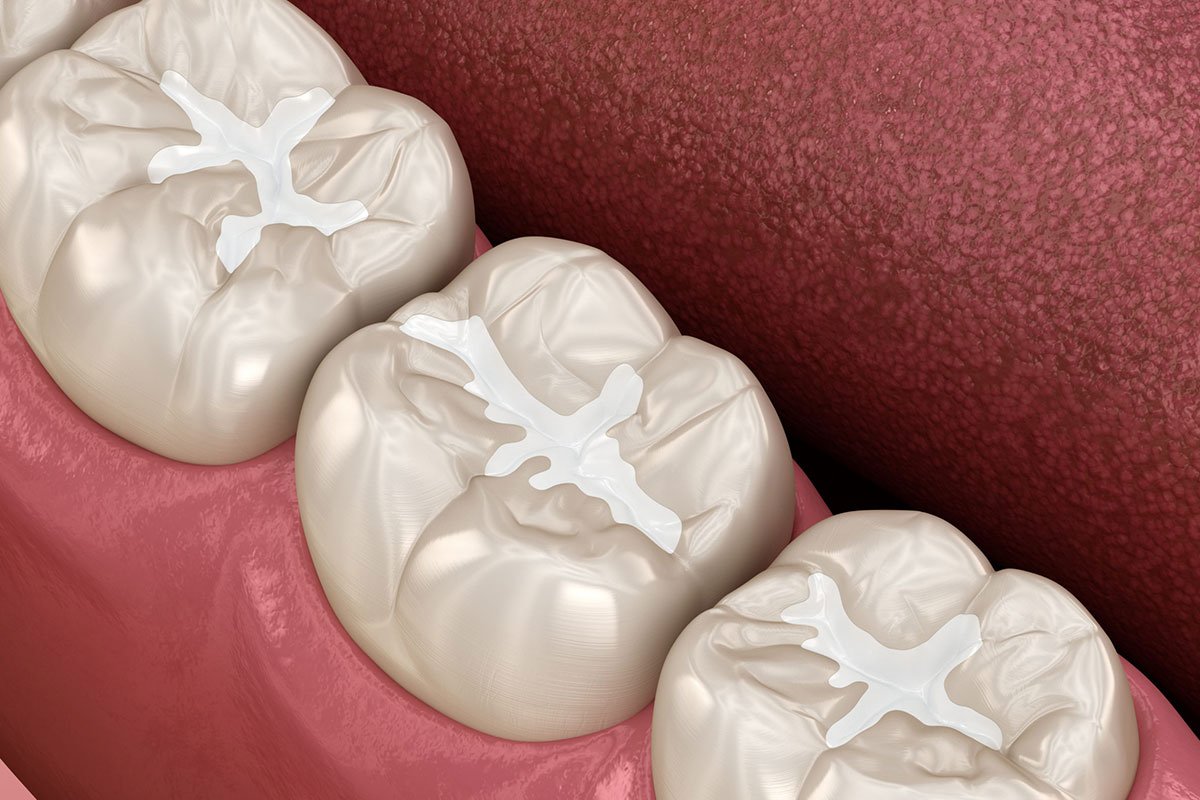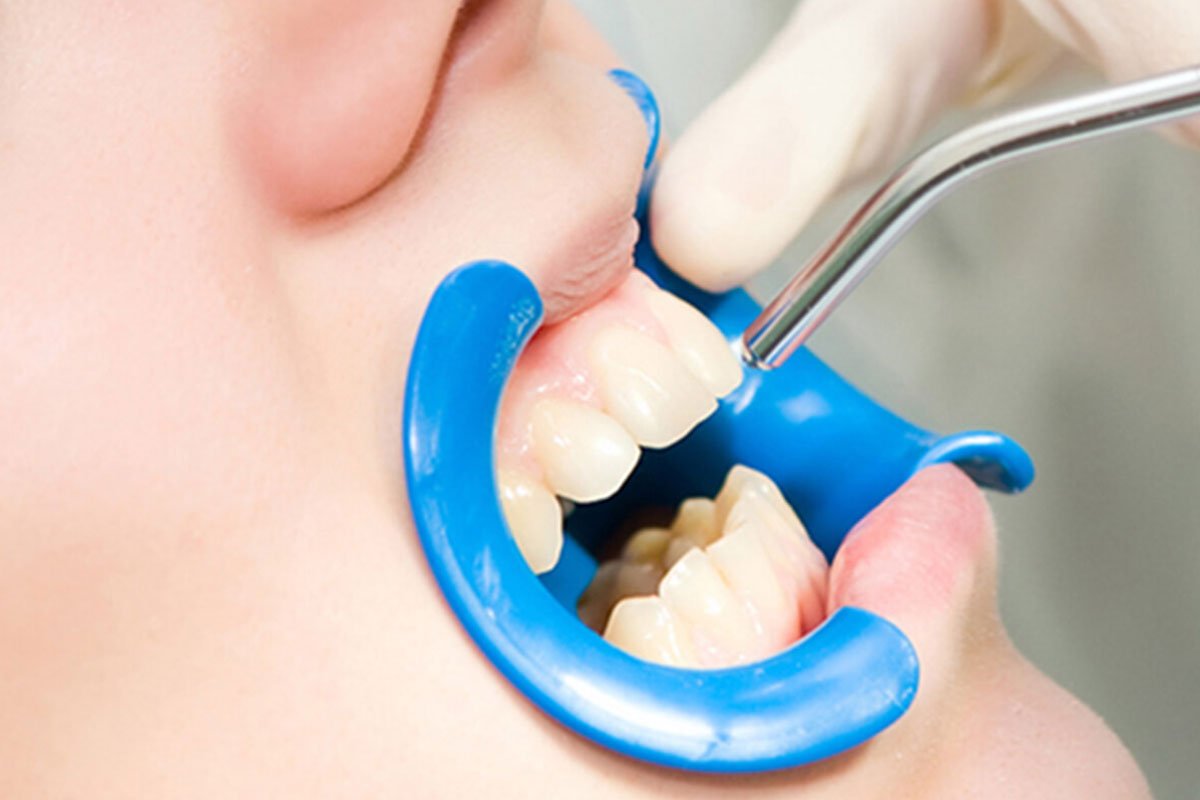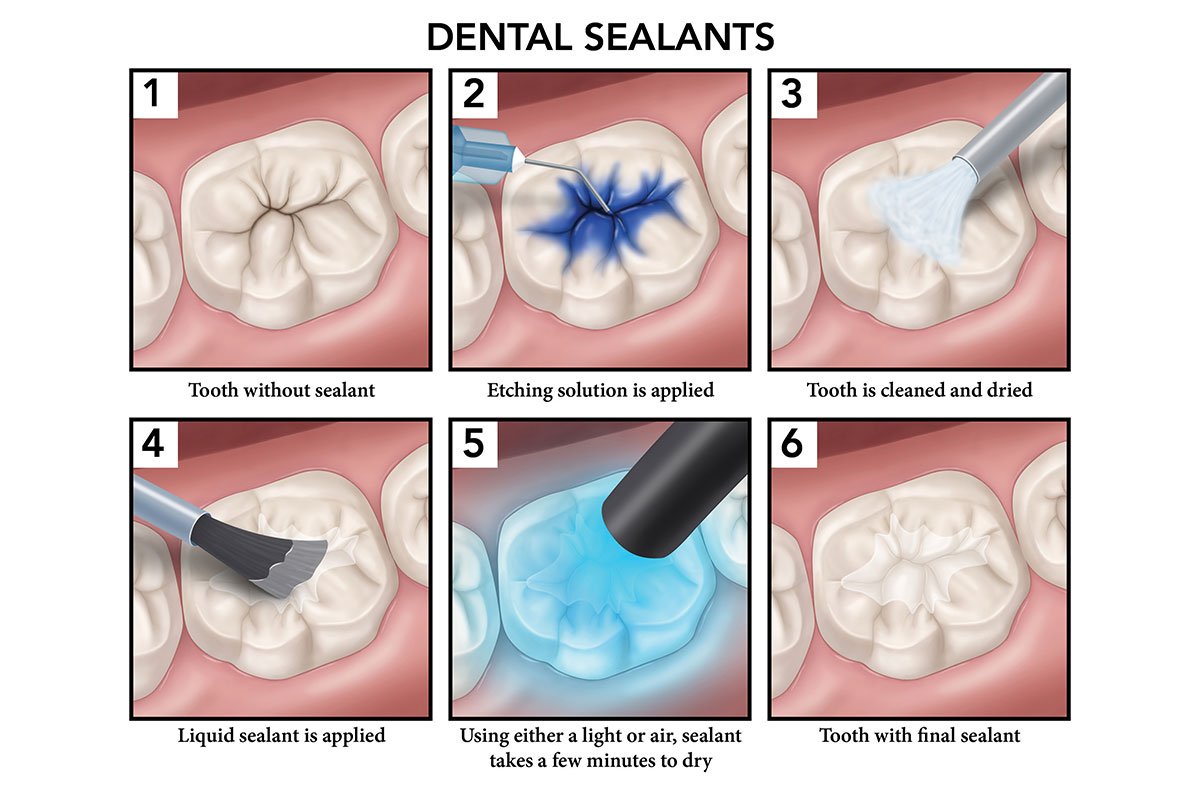Dental sealants are thin plastic coatings that act as a barrier and are painted on the chewing surfaces of the back teeth (molars) in order to prevent cavities or tooth decay for prolonged periods. Sealants protect chewing surfaces from decay by covering them with a protective shield that blocks out food debris and germs.
Sealants are a type of dental treatment that provides protection against almost 80% of cavities for 2 years and continue to protect against around 50% of cavities for up to 4 years. Sealants are a painless, non-invasive, and easy way to prevent cavities. They are necessary to protect the form and function of original teeth.
A tooth without cavities or decay is healthier and stronger than a tooth with a filling or untreated decay. Furthermore, sealants are also less expensive and easier to apply than dental fillings. Adults who are at risk for cavities or do not have fillings can also get sealants, but they are most commonly suggested for children.
TYPES OF DENTAL SEALANTS:
Generally, sealants are a combination of fillers, chemicals, and resins. Some materials in the composition of sealants may be more resistant to wear; others might more readily flow into the fissures and pits of a child’s teeth. But regardless of the option one chooses for treatment, they are perfectly safe. There are various types of dental sealants, such as:
1. GLASS IONOMER:
Glass ionomer sealants usually consist of an essentially flexible paste that is used to form a tight seal between the internal tooth and the surrounding environment, allowing the tooth to remain protected.
This flexible paste is completely safe for baby teeth. When bonded to teeth, It slowly releases fluoride that strengthens the tooth’s enamel for a long time. However, glass ionomer sealants are not as durable as resin ones.
Still, they provide significant protection against dental caries during the treatment. Moreover, glass ionomer materials blend very well with a patient’s natural tooth colour, so many people consider sealants as a functional and visually pleasing treatment.


2. COMPOSITE RESIN:
Composite resin sealants are crafted out of a plastic known as acrylic resin. This material blends well with natural teeth, offers a tooth-colored appearance, and is comparatively more durable. These sealants are bonded to the chewing surface of molars and premolars in order to protect vulnerable areas from tooth decay and cavities. However, sealants fabricated from composite resin do not release fluoride and cannot provide any additional benefits to people.
APPROXIMATE COSTS OF DENTAL SEALANTS:
Without insurance, dental sealants can cost you around $30 to $40 per tooth. However, these costs are inconsistent and vary greatly. Sometimes dentists can set their own rates, so one should search the area in order to find the best dental sealant price. Generally, the amount of sealants is quite inexpensive compared to other dental treatments and most of the time; dental insurance covers the cost of sealants.
Sealants, in addition to providing benefits to children, can also be used for adults who are looking to minimise the chances of tooth decay. They are also a form of preventative dental approach that protects your teeth from future dental issues arising from bacterial buildup and plaque decay.
HOW ARE SEALANTS APPLIED?
Applying sealant is a quite painless and simple process. It takes only a few minutes for your dentist or oral hygienist to apply the sealant in order to seal each tooth.
The application steps usually involve the following:
- Firstly, the dentist thoroughly cleans and seals the teeth of patients.
- Each tooth is then individually dried, and after that, any absorbent material, such as cotton, is put around the tooth to keep it dry.
- An acid solution is then placed on the chewing surfaces of the teeth to roughen them up, which aids the sealant bond to the teeth.
- The teeth are then thoroughly rinsed and dried.
- The sealant is then painted onto the tooth enamel, bonding directly to the tooth and sometimes a special curing light is also used to help the sealant harden.

PROS AND CONS OF SEALANTS:
PROS:
1. SEALANTS ARE SUITABLE FOR ALL AGES:
Children are the most common age demographic for this treatment, but anyone can share the same benefits. Permanent teeth of older patients are also riddled with minor grooves that need to be covered to protect the tooth from cavities and decay.
2. THEY PROTECT AGAINST CAVITIES:
Dental sealants effectively protect teeth from cavities by covering the molar’s top with a “tooth-coloured” plastic. This additional layer of protection makes it difficult for bacteria to invade the inner surface of a tooth. The teeth are thoroughly cleaned to remove hidden food particles or plaque before the application of sealants.
3. THEY REDUCE DEEP GROOVES:
The posterior teeth (molars) have relatively deeper depressions and grooves on the surfaces and are more challenging to clean. Toothbrush bristles cannot reach all the groves and depressions on teeth chewing surfaces. Most unreachable spots become a reason for plaque buildup. Eventually, these deep depressions and grooves will lead a tooth to severe dental decay. Sealants can effectively prevent decay from developing in these vulnerable areas.
4. THE PROCESS IS QUICK AND PAINLESS:
The process of applying dental sealants is quite simple and non-invasive. Before their application, teeth are cleaned and prepared by using a mild solution that is similar in strength to vinegar or lemon juice. Once the tooth is prepared, the sealant is applied to the teeth. The sealant material flows into grooves and depressions and fills them.
5. THEY ARE LONG-LASTING:
Applying sealants in the early years can protect the teeth throughout cavity-prone years because sealants can last for extended periods with proper care. During routine dental visits, the dentist can also check the sealants and may recommend re-application or repair when required.
Moreover, sealants are much more cost-effective than other dental restorative or preventative treatments.
CONS:
1. COST:
Dental sealants may not be covered by some insurance plans, so patients may have to pay for them out of pocket.
2. LIMITED LIFESPAN:
Sealants typically last for several years, but they will eventually wear down and need to be replaced.
3. MAY NOT BE SUITABLE FOR ALL TEETH:
Sealants are most effective on the smooth surfaces of molars and premolars, but they may not bond well to tooth surfaces that are rough or uneven.










